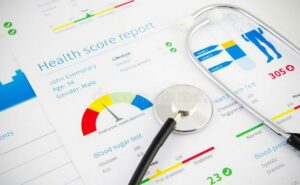Contents
- 1 Occupational Health Screening Guide
- 2 Who Goes Through Occupational Health Screening Guide?
- 3 What Is The Purpose Of Occupational Health Screening?
- 4 What To Look For In Occupational Health Screenings?
- 5 Requirements For The Employer To Provide This Service
- 6 Benefits Of Having An Occupational Health Screening In Your Workplace
- 7 What To Expect During An Occupational Health Assessment?
- 8 A Word From MantraCare
Occupational Health Screening Guide

Occupational health screening is the process of assessing the risk factors in the workplace. It might include pre-employment screenings, ongoing screening during employment, or medical examinations. That is needed to determine minimal fitness for work. These screenings involve everything from blood pressure to drug testing.
One of the most common types of occupational health screenings is a post-offer or pre-employment physical exam. This exam will identify if any history of substance abuse may be an issue with the job in question. As well as any major chronic illnesses or communicable diseases that may not be known by the potential employee. This exam also includes an EKG or chest x-ray to ensure that there are no heart problems that would put the worker in danger by performing certain tasks.
The last type of screening that is commonly used is random drug testing, for either safety purposes or to verify that employees are not misusing drugs while on the job.
Who Goes Through Occupational Health Screening Guide?
If you are looking for a job, it is likely that your potential employer will require an occupational health screening.
The goal of occupational health screening is to assess the risks in the workplace and make sure that there are no major risk factors that may cause harm or injury to any employees. The Occupational Health Screening Guide provides details on what kind of screenings employers might require, who should be screened, and when these screenings can take place.
What Is The Purpose Of Occupational Health Screening?

Health screening programs are typically performed in the workplace and there is a federal requirement that all employees undergo an occupational health screening. These screenings can be done either on-site or by a physician in the clinic. The decision to perform the screening at your site or to refer employees for medical assessment is determined by the nature of the work itself and any health concerns that an employer has about its employees.
Your occupational health program should address any issues that pose a direct threat to the employee’s safety as well as those that may lead to more indirect risks. An example of a direct risk is the employee who works with heavy machinery and who has a condition that limits his or her ability to see. An example of an indirect risk is the employee who works in a poorly lit environment over an extended period of time and develops serious eye problems, such as cataracts.
In most cases, however, your occupational health screening plan should focus on the direct and immediate risks that affect your workforce.
What To Look For In Occupational Health Screenings?
The reason for the occupational health screen will typically determine what you look for in the results. Your general corporate policy may dictate certain parameters such as blood pressure, cholesterol, vision tests, and heart rate. However, if your company is undergoing an ergonomic assessment, you will also be checking for musculoskeletal risks.
The following are standard tests that may be included in your occupational health screening:
Some Common Tests
 Blood pressure checks; cholesterol and triglyceride levels (lipids); glucose levels (also called blood sugar); protein in the urine; liver function tests; heart rate; EKG (electrocardiogram); anemia screening; hearing tests; vision tests; respirator medical clearance, respiratory protection fit-testing, and quality assurance programs for respiratory protection devices.
Blood pressure checks; cholesterol and triglyceride levels (lipids); glucose levels (also called blood sugar); protein in the urine; liver function tests; heart rate; EKG (electrocardiogram); anemia screening; hearing tests; vision tests; respirator medical clearance, respiratory protection fit-testing, and quality assurance programs for respiratory protection devices.
These are minimum standards that you should be including in your occupational health screening program to ensure that all employees are physically capable of performing their jobs safely and efficiently.
In addition to the standard screenings that your corporate policy may mandate, you should also consider using a biological or chemical monitoring program in some work environments. Employees who are exposed to hazardous substances in their jobs often have unique medical needs.
Chemical exposure may present a particularly difficult problem because of the possible long-term effects associated with many chemical exposures.
Blood pressure checks; cholesterol and triglyceride levels (lipids); glucose levels (also called blood sugar); protein in the urine; liver function tests; heart rate; EKG (electrocardiogram); anemia screening; hearing tests; vision tests; respirator medical clearance, respiratory protection fit-testing, and quality assurance programs for respiratory protection devices.
These are minimum standards that you should be including in your occupational health screening program to ensure that all employees are physically capable of performing their jobs safely and efficiently.
In addition to the standard screenings that your corporate policy may mandate, you should also consider using a biological or chemical monitoring program in some work environments. Employees who are exposed to hazardous substances in their jobs often have unique medical needs.
Chemical exposure may present a particularly difficult problem because of the possible long-term effects associated with many chemical exposures.
Chemical Monitoring Programs
 Many types of chemical monitoring programs are available, so you need to use your judgment to determine which one is best for your company. For example, continuous biological monitoring programs involve the regular testing of employee blood or urine. Skin tests are sometimes used to check for certain types of chemicals by exposing an area of skin on the inside forearm to a small amount of the substance being tested.
Many types of chemical monitoring programs are available, so you need to use your judgment to determine which one is best for your company. For example, continuous biological monitoring programs involve the regular testing of employee blood or urine. Skin tests are sometimes used to check for certain types of chemicals by exposing an area of skin on the inside forearm to a small amount of the substance being tested.
There are also short-term screening tests that provide an indication of whether a substance is present in the body and what level it is at. These tests usually take one to three days to complete, depending on the type of test that is used.
Biological Monitoring
Biological monitoring programs are particularly helpful when exposure levels cannot be determined by other means such as direct measurement or air sampling. They can also be used to determine the effectiveness of engineering controls that are being used in an occupational setting.
Employers may also conduct physical examinations, including routine laboratory tests that are performed periodically on employees who wear respirators when working under conditions where facepiece seal leakage is likely. The purpose of these measurements is to assure that approved respirators fit properly and will protect the wearer from injury or illness resulting from breathing harmful atmospheres.
The results of all biological monitoring and other medical tests should be kept confidential and shared only with those individuals who have a need to know such as the employee’s supervisor, physician, and industrial hygienist.
In addition to providing confidential medical tests for employees, employers should also provide a medical examination. When an employee’s work performance is being adversely affected by a potential or existing medical condition. This would include addressing any problems that arise as a result of sickle cell trait or disease, diabetes, epilepsy, tuberculosis, respiratory tract infections, asthma, lead poisoning, or anemia.
Drug Testing
 Employees who are being considered for employment must have a pre-employment physical examination which may include drug testing. However, during the course of employment certain conditions may arise that require additional physical examinations or drug tests.
Employees who are being considered for employment must have a pre-employment physical examination which may include drug testing. However, during the course of employment certain conditions may arise that require additional physical examinations or drug tests.
These could include a return to work program after a long absence from the workplace, medical-legal issues where physical capabilities are an issue, an unexpected illness or injury, a report of significant exposure to hazardous chemicals while on the job, and suspicion of substance abuse at work.
Employees who are required to wear respirators as a condition of their employment must be physically able to perform the essential functions of the job, including wearing a respirator. In addition, they must also have received a physical examination and be determined fit for wearing a respirator by a physician knowledgeable about respiratory hazards in the workplace environment. The additional physical examination should be performed before the initial assignment to tasks requiring the use of a respirator.
Employers also have the discretion to provide physical examinations and drug tests of employees. Those who may be exposed to hazardous levels of toxic agents and whose job performance could be adversely affected by such exposure if certain conditions are met. These would include:
- Employees with complaints of possible health problems related to their current job,
- Employees who are exposed to hazards above permissible exposure limits which require the use of respiratory protection,
- A situation where an individual’s work performance is being adversely affected by a potential or existing medical condition.
Requirements For The Employer To Provide This Service
Employers must be cognizant of the requirements for the employer to provide this service. Employers are required to provide physical examinations and drug tests of employees who may be exposed to hazardous levels of toxic agents or whose work performance may be adversely affected by a medical condition. This service is only permitted when certain conditions are met.
These conditions include an employee with complaints of possible health problems related to their current job. An employee with exposure above the permissible exposure limits. And an employee whose work performance is being adversely affected by a potential or existing medical condition.
Benefits Of Having An Occupational Health Screening In Your Workplace

There are a number of benefits to having an occupational health screening in your workplace. One major benefit is that it reduces the risk of physical and mental stress, which could be caused by work. It can also help prevent workplace accidents and illnesses, such as cancer. Further, occupational health screenings can improve employee productivity and decrease absenteeism rates. The only downside to occupational health screenings is that employers must pay for them. If they’re offered in the company’s healthcare plan.
A few benefits that I’ve found that come with occupational health screenings are:
- Reduced stress levels
- Improved safety in workplaces
- Increased confidence in your employer
- Lower chance of getting cancer
- Decreased rates of absenteeism
- Improved employee productivity
Negatives Of Occupational Health Screening
My research found that there were really no negatives to having an occupational health screening, except if the employer has to pay for it. From what I’ve learned, occupational health screenings are very useful in many different industries. For example, they make sure people aren’t working in dangerous environments with harmful chemicals. The screenings are a way to simply make sure employees are physically and mentally healthy to work.
What To Expect During An Occupational Health Assessment?

Many types of occupational health assessments are available to suit the needs of various workplace environments. These may include mental, physical, or medical assessments. Each type of assessment will aim to collect information about the worker’s overall health and well-being. The worker should be aware that he/she may need to ask personal questions. Such as their family history and any chronic conditions they may have. The examination will also involve looking at the worker’s environment, such as assessing any risks in their workspace or how much sleep they get at night.
Occupational health screening is an important service that employers must provide to their employees. Employers may ask employees to give physical examinations and drug tests, If certain conditions are in suspect. The employer can offer this service as well as mental, physical, or medical assessments for various workplace environments. These occupational health screenings will take into account personal questions about family history and chronic illness in order to assess the worker’s overall health and wellbeing. This is a great resource for all types of businesses. Like small start-ups with 10 employees up to large corporations with hundreds of workers on staff.
A Word From MantraCare
Do you want to keep your employees happy, healthy, and productive? Join our employee assistance program and get a healthier workplace.



